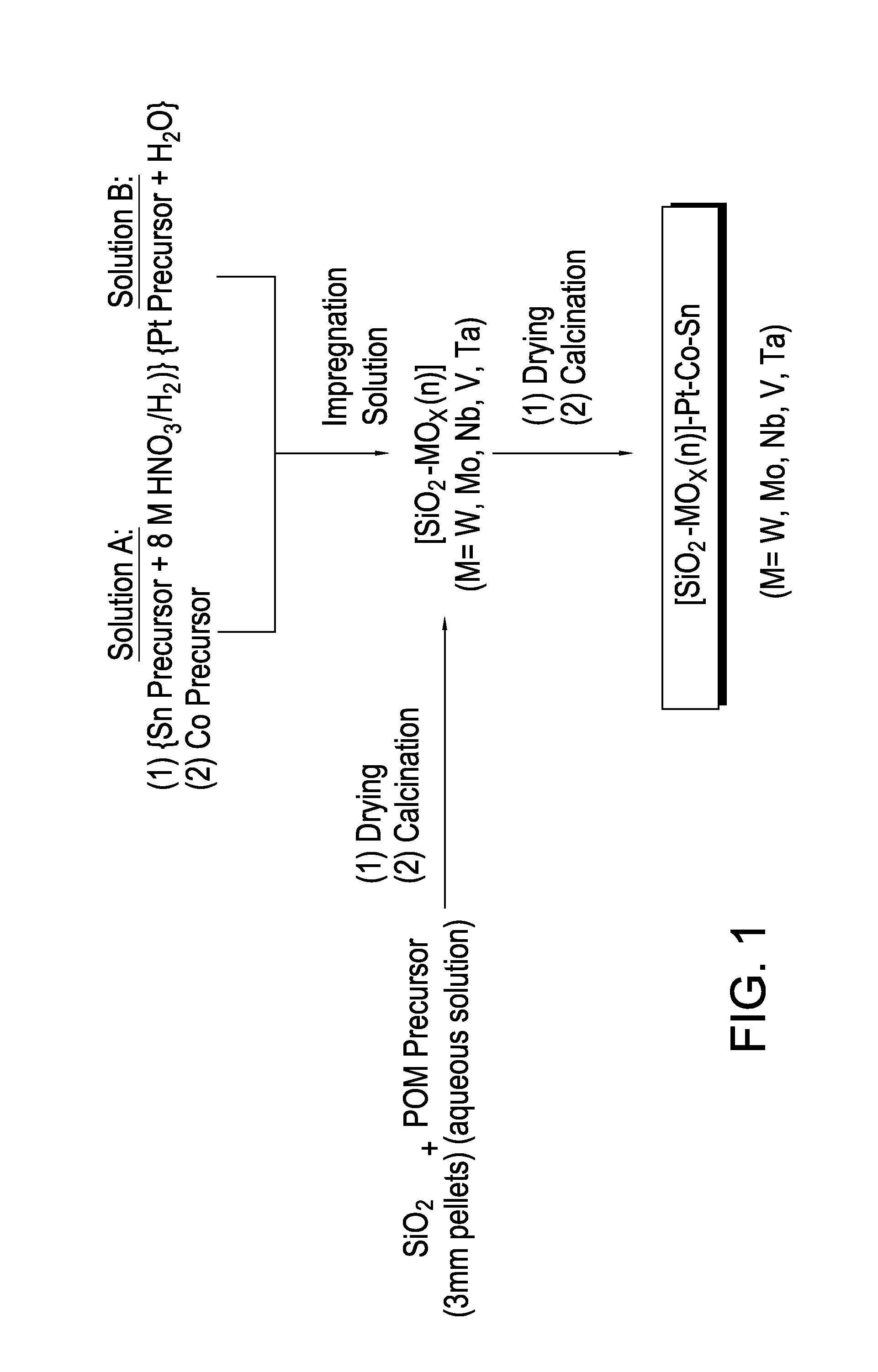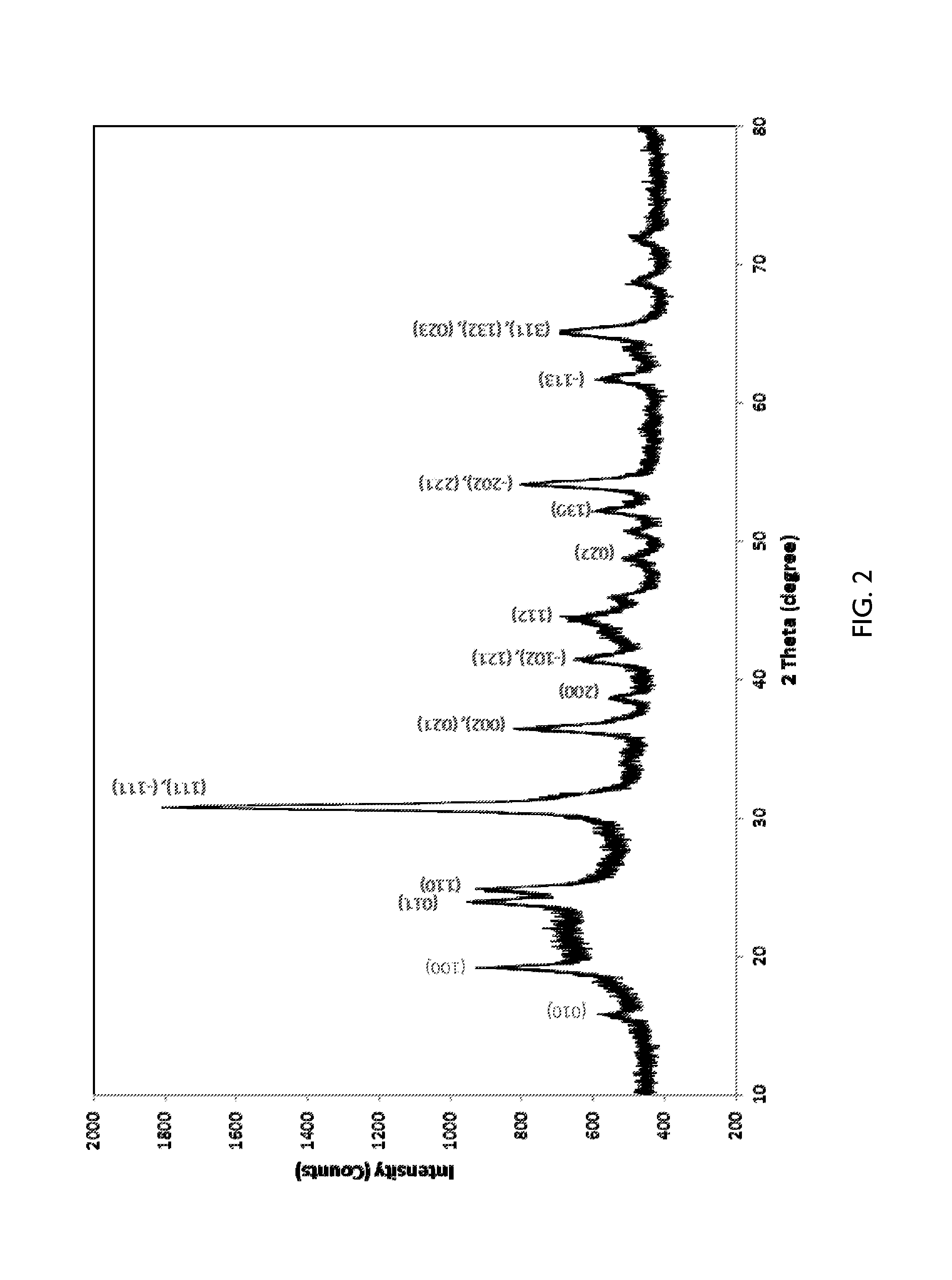Hydrogenation Catalysts
a technology of hydrogen catalysts and catalysts, applied in the field of catalysts, can solve the problems of affecting the commercial viability of catalysts, requiring excessive operating temperatures and pressures, and catalysts which are prohibitively expensive and/or non-selectiv
- Summary
- Abstract
- Description
- Claims
- Application Information
AI Technical Summary
Benefits of technology
Problems solved by technology
Method used
Image
Examples
example 1
Pt(1.09)Co(3.75)Sn(3.25) / CoSnWO3 / SiO2
[0105]A. Preparation of Modified Support: Co(3.75)Sn(3.25)WO3(12) / SiO2
[0106]A summary of the catalyst preparation protocol is provided in FIG. 1. A metal impregnation solution was prepared as follows. First, a solution of tin salt was prepared by adding 8.56 g (0.0414 mol) of SnC2O4 (solid) slowly into 41 g (0.328 mol) of 8M HNO3 in a 300 ml beaker while stifling. 70 g of DI-H2O was then added to further dilute the solution. 28 g (0.0962 mol) of Co(NO3)2.6H2O solid was then added to the above solution with stirring. After the Co salt was completely dissolved, 19.47 g (0.079 mol W) of ammonium metatungstate (AMT) was added to the above solution. The mixture was then stirred at 400 rpm for another 5 minutes at room temperature.
[0107]The solution was then added to 120 g SiO2 support in a one-liter round flask by using incipient wetness techniques to provide a uniform distribution on the support. After adding the solution, the material was evacuate...
example 2
Pt(1.09)Co(3.75)Sn(3.25) / CoSnWO3 / SiO2
[0111]A. Preparation of Modified Support: Co(3.75)Sn(3.25)WO3(12) / SiO2
[0112]A metal impregnation solution was prepared as follows. First, a solution of tin salt was prepared by adding 15.67 g (0.045 mol) of Sn(IV)Cl4.5H2O (solid) into 100 g of DI-H2O. 30.23 g (0.104 mol) of Co(NO3)2.6H2O (solid) was added to the solution with stifling. After the cobalt salt was completely dissolved, 21.03 g (0.085 mol of W) of AMT was added to the solution. The mixture was then stirred at 400 rpm for another 5 minutes at room temperature.
[0113]The resulting solution was then added to 129.6 g. SiO2 support in a one-liter round flask by using incipient wetness techniques to provide a uniform distribution on the support. After adding the metal solution, the material was evacuated to dryness using a rotary evaporator with bath temperature at 80° C. and vacuum at 72 mbar for 2 hours, followed by drying at 120° C. for 12 hours under circulating air and calcination at...
example 3
Pt(1.09)Co(3.75)Sn(3.25) / CoSnWO3 / SiO2
[0117]A. Preparation of Modified Support: Co(3.75)Sn(3.25)WO3(12) / SiO2
[0118]A metal impregnation solution was prepared as follows. First, a solution of tin salt was prepared by dissolving 2.476 g of Sn(II)Cl2.2H2O (solid) into the 25 g of DI-H2O. 7.559 g of Co(NO3)2.6H2O solid was add to the solution with stifling. After the Co salt was completely dissolved, 5.257 g of AMT was added to the solution. The mixture was then stirred at 400 rpm for another 5 minutes at room temperature.
[0119]The resulting solution was then added to 32.4 g SiO2 support in a one-liter round flask by using incipient wetness technique to provide a uniform distribution on the support. After adding the metal solution, the material was evacuated to dryness using a rotary evaporator with bath temperature at 80° C. and vacuum at 72 mbar for 2 hours, followed by drying at 120° C. for 12 hours under circulating air and calcination at 600° C. for 8 hours. Temperature Program: in...
PUM
| Property | Measurement | Unit |
|---|---|---|
| Fraction | aaaaa | aaaaa |
| Fraction | aaaaa | aaaaa |
| Angle | aaaaa | aaaaa |
Abstract
Description
Claims
Application Information
 Login to View More
Login to View More - R&D
- Intellectual Property
- Life Sciences
- Materials
- Tech Scout
- Unparalleled Data Quality
- Higher Quality Content
- 60% Fewer Hallucinations
Browse by: Latest US Patents, China's latest patents, Technical Efficacy Thesaurus, Application Domain, Technology Topic, Popular Technical Reports.
© 2025 PatSnap. All rights reserved.Legal|Privacy policy|Modern Slavery Act Transparency Statement|Sitemap|About US| Contact US: help@patsnap.com


